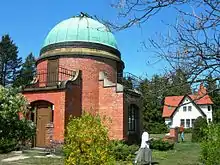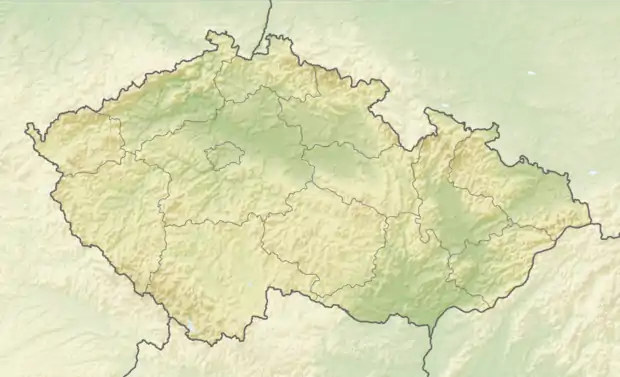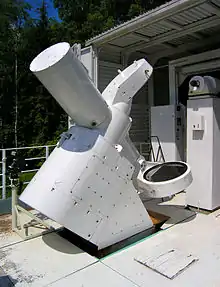Ondřejov Observatory
The Ondřejov Observatory (pronounced [ˈondr̝ɛjof]; Czech: Observatoř Ondřejov) is the principal observatory of the Astronomical Institute (Astronomický ústav) of the Academy of Sciences of the Czech Republic. It is located near the village of Ondřejov, 35 kilometres (22 miles) southeast of Prague, Czech Republic.[1] It has a 2-metre (6 ft 7 in) wide telescope, which is the largest in the Czech Republic.
 Historic cupola of the Ondřejov Observatory | |
| Organization | Astronomical Institute of Czech Academy of Sciences |
|---|---|
| Observatory code | 557 |
| Location | Ondřejov, Prague-East District, Central Bohemian Region, , Czechia |
| Coordinates | 49°54′55″N 14°46′52″E |
| Altitude | 500 m (1,600 ft) |
| Established | 1898 |
| Telescopes | Ondřejov 0.65-m telescope Ondřejov 2-m telescope Ondřejov radio telescope |
 Location of Ondřejov Observatory | |
History
The facility was constructed in 1898, by Czech amateur astronomer and entrepreneur Josef Jan Frič as a private observatory. On 28 October 1928, he donated the facility to the Czechoslovak state to celebrate the tenth anniversary of its independence.[2] The observatory, located at an altitude of 500 metres (1,600 ft), away from the air and light pollution of urban Prague, was administered by Charles University until the founding of the Czechoslovak Academy of Sciences in 1953, which from then on operated it as part of its Astronomical Institute in conjunction with other Czechoslovak observatories.
In 1967, a telescope measuring 2 metres (6 ft 7 in) in width was added to the observatory, which at that time was the 7th largest telescope in the world. Now it is the largest telescope in the Czech Republic and is in the second hundred in the world.[3]
It has been responsible, among other scientific achievements, for the discovery of numerous asteroids; more recent works of astronomers from Ondřejov include examination of the trajectory and origin of the Chelyabinsk meteor. More than 700 minor planets have been discovered at this observatory.[4] While most of these discoveries are officially credited to the astronomers who discovered them, a remaining 23 minor planets are directly credited to "Ondrejov" (the observatory itself) by the Minor Planet Center for the period 1997–2008.[5]
The main-belt asteroid 7204 Ondřejov, discovered by Petr Pravec in 1995, was named for the village where the observatory is located.[1]
| see § List of discovered minor planets |
List of discovered minor planets
| 31139 Garnavich | 25 September 1997 | list |
| 37788 Suchan | 25 September 1997 | list |
| 42924 Betlem | 2 October 1999 | list |
| 42981 Jenniskens | 2 October 1999 | list |
| 53285 Mojmír | 24 March 1999 | list |
| 76713 Wudia | 6 May 2000 | list |
| 82559 Emilbřezina | 28 July 2001 | list |
| (109353) 2001 QS153 | 26 August 2001 | list |
| (113389) 2002 SF17 | 28 September 2002 | list |
| (119113) 2001 OE77 | 28 July 2001 | list |
| 127196 Hanaceplechová | 16 April 2002 | list |
| (131423) 2001 OF77 | 29 July 2001 | list |
| (138439) 2000 HD98 | 26 April 2000 | list |
| (164782) 1999 DK4 | 16 February 1999 | list |
| (172097) 2002 EX107 | 8 March 2002 | list |
| (216476) 1999 SC22 | 23 September 1999 | list |
| (264493) 2001 PS50 | 15 August 2001 | list |
| (281660) 2008 VQ13 | 5 November 2008 | list |
| (286148) 2001 TG217 | 14 October 2001 | list |
| (316333) 2010 RP123 | 19 September 2001 | list |
| (337680) 2001 TR209 | 12 October 2001 | list |
| (352835) 2008 VR13 | 6 November 2008 | list |
| (362805) 2011 YZ4 | 2 December 1999 | list |
Gallery
 Ten-meter solar flux monitor at Ondřejov.
Ten-meter solar flux monitor at Ondřejov..jpg.webp) 10-m radio telescope with Venus and Jupiter in the sky.
10-m radio telescope with Venus and Jupiter in the sky..jpg.webp) The dome of the 65-cm telescope.
The dome of the 65-cm telescope..jpg.webp) The dome of the 2-m telescope.
The dome of the 2-m telescope. Solar Telescope.
Solar Telescope. Solar Telescope with outer housing.
Solar Telescope with outer housing. Horizontal Solar Spectrograph.
Horizontal Solar Spectrograph. Central plain with former J. J. Frič house.
Central plain with former J. J. Frič house. Robotic telescope BART.
Robotic telescope BART.
See also
References
- Schmadel, Lutz D. (2007). "(7204) Ondřejov". Dictionary of Minor Planet Names – (7204) Ondřejov. Springer Berlin Heidelberg. p. 583. doi:10.1007/978-3-540-29925-7_6350. ISBN 978-3-540-00238-3.
- Dorschner, J., & Löffler, G., Astronomy, a Popular History, (New York City: Van Nostrand Reinhold, 1975).
- "Největší dalekohled v Česku vznikl před 50 lety se štěstím. Teď zkoumá vzdálený vesmír". Aktuálně.cz (in Czech). 23 August 2017.
- "Numbered asteroids discovered at Ondřejov". Ondřejov Obsrevatory. 1 March 2016. Retrieved 9 January 2017.
- "Minor Planet Discoverers (by number)". Minor Planet Center. 14 November 2016. Retrieved 29 November 2016.
External links
 Media related to Ondřejov Observatory at Wikimedia Commons
Media related to Ondřejov Observatory at Wikimedia Commons- Astronomical Institute, responsible for the observatory
- Photos of the observatory
- News from Ondřejov Photometric Program
- Numbered asteroids discovered at Ondřejov, 1 June 2018